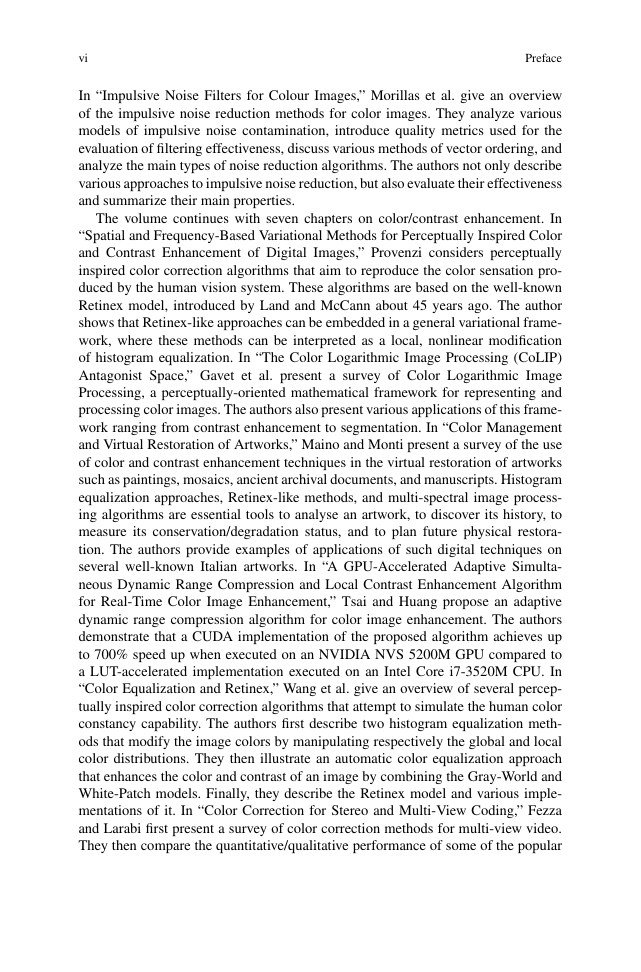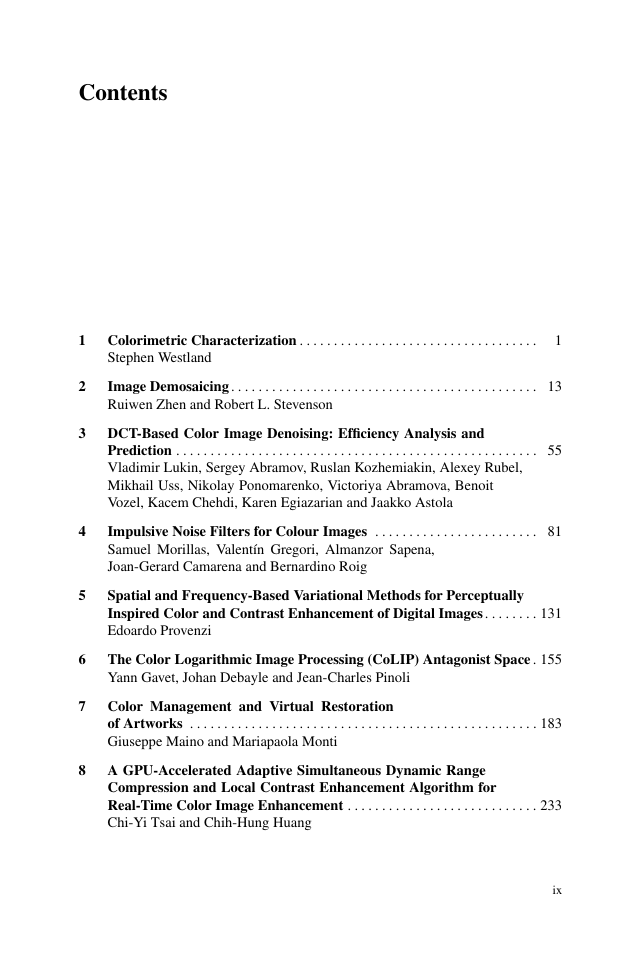Cover
Preface
Contents
Contributors
1 Colorimetric Characterization
1.1 Introduction
1.2 CIE XYZ
1.3 sRGB
1.4 Color Correction
1.5 Theoretical Relationship between RGB and XYZ
1.6 Data-Based Color-Correction Methods
1.7 Applications and Limitations
1.8 Conclusions
References
2 Image Demosaicing
2.1 Introduction
2.1.1 Demosaicing
2.1.2 Demosaicing Artifacts
2.1.3 Demosaicing Principles
2.1.4 Evaluation Criteria
2.2 Demosaicing Approaches
2.2.1 Edge-Sensitive Methods
2.2.2 Directional Interpolation and Decision Methods
2.2.3 Frequency-Domain Approaches
2.2.4 Wavelet-Based Methods
2.2.5 Statistical Reconstruction Techniques
2.2.6 Experimental Results
2.3 Advanced Topics
2.3.1 Joint Demosaicing and Deblurring
2.3.2 Joint Demosaicing and Super-Resolution
2.4 Conclusion
References
3 DCT-Based Color Image Denoising: Efficiency Analysis and Prediction
3.1 Introduction
3.2 Image and Noise Properties
3.2.1 Image Properties
3.2.2 Noise Models
3.3 Considered Filters and Quantitative Criteria
3.4 Component-Wise Denoising and Prediction
3.5 3D Denoising of Color Images
3.6 Conclusions
References
4 Impulsive Noise Filters for Colour Images
4.1 Modelling Impulsive Noise
4.1.1 Measuring the Quality of a Filter
4.2 Robust Filters For Impulsive Noise
4.2.1 Comparison of Robust Methods
4.3 Adaptive Filtering
4.3.1 Partition Based Filters
4.3.2 Switching Filters
4.3.2.1 Based on Robust Statistics
4.3.2.2 Based on Peer Groups
4.3.2.3 Using Fuzzy Metrics
4.3.2.4 Using Quaternions
4.3.2.5 Noise Detection in Several Steps
4.3.2.6 Based on Morphological Operations
4.3.3 Filters Based on Weighted Coefficients
4.3.4 Fuzzy Filters
4.3.5 Regularization Filters
4.3.6 Comparison of Advanced Adaptive Methods
References
5 Spatial and Frequency-Based Variational Methods for Perceptually Inspired Color and Contrast Enhancement of Digital Images
5.1 Introduction
5.2 Variational Interpretation of Histogram Equalization
5.3 A Basic Set of HVS Properties
5.3.1 Adaptation to the Average Luminance Level
5.3.2 Local Contrast Enhancement
5.3.3 Color Constancy
5.3.4 Weber's Law
5.4 Variational Perceptually Inspired Color Enhancement of Digital Images
5.4.1 Stability of the Numerical Scheme for the Minimization of Perceptual Functionals and Reduction of Computational Complexity
5.4.2 Relationship with Existing Perceptually Inspired Color Correction Models
5.5 Wavelet-based Implementation of Variational Perceptually Inspired Color Correction
5.5.1 Adjustment to the Average Value in the Wavelet Domain
5.5.2 Local Contrast Enhancement in the Wavelet Domain
5.6 Conclusions and Future Perspectives
Appendix 1
Appendix 2
References
6 The Color Logarithmic Image Processing (CoLIP) Antagonist Space
6.1 Introduction
6.2 Human Color Perception
6.2.1 Trichromacy and Color Photoreception
6.2.2 Opponent Process
6.2.3 Just Noticeable Differences and Logarithmic Laws
6.2.4 Color Representation Systems and Conversions
6.2.4.1 XYZ to LMS Conversion
6.2.4.2 sRGB to XYZ Conversion
6.2.4.3 XYZ to L*a*b* Conversion
6.3 LIP
6.3.1 Gray-Tone Functions
6.3.2 The Vectorial Structure
6.3.3 Illustrations and Applications
6.3.3.1 Elementary Operations Illustrations
6.3.3.2 Dynamic Range Maximization
6.4 CoLIP
6.4.1 From Cone Intensities to Achromatic and Chromatic Tones
6.4.1.1 Color Tones
6.4.1.2 Color Logarithmic Response
6.4.1.3 Opponent Process
6.4.2 The Trichromatic Antagonist Vectorial Structure
6.4.3 Bounded Vector Space
6.4.4 Summary
6.5 Psychophysical Connections
6.5.1 Color Combination
6.5.2 Comparison with the L*a*b* Space
6.5.3 Color-Matching Functions
6.5.4 Chromaticity Diagram and the Maxwell Triangle
6.6 Application to Image Processing and Analysis
6.6.1 Contrast Enhancement
6.6.1.1 Histogram Equalization
6.6.1.2 Dynamic Enhancement
6.6.2 White Balance Correction
6.6.3 Color Transfer
6.6.4 K-Means Clustering
6.6.5 Mathematical Morphology
6.6.5.1 Color Morphology
6.6.5.2 CoLIP Morphology
6.6.5.3 CoLIP Image Enhancement
6.7 Concluding Discussion and Perspectives
References
7 Color Management and Virtual Restoration of Artworks
7.1 Introduction
7.2 Color Perception
7.3 The Retinex Approach and Other Techniques of Color Enhancement
7.4 Color and Painting Restoration
7.5 Multispectral Images
7.6 Applications to Paintings
7.7 Principal Component Analysis
7.8 Evaluation of Restoration Work: A Case Study
7.9 Applications to Mosaics
7.10 3D Applications
7.11 Conclusions
References
8 A GPU-Accelerated Adaptive Simultaneous Dynamic Range Compression and Local Contrast Enhancement Algorithm for Real-Time Color Image Enhancement
8.1 Introduction
8.2 The Existing SDRCLCE Algorithm
8.3 The Adaptive SDRCLCE Algorithm
8.3.1 An Existing Adaptive Intensity Transfer Function
8.3.2 Application of SDRCLCE Formula into the Adaptive Intensity Transfer Function
8.3.3 Extension to Video Signal Processing
8.4 GPU Acceleration of the Adaptive SDRCLCE Algorithm
8.4.1 2D LLUT Update
8.4.2 Local Average Computation
8.4.3 2D LLUT Indexing
8.5 Experimental Results
8.5.1 Quantitative and Visual Comparisons Between CPU and GPU Implementations
8.5.2 Computational Performance Analysis
8.6 Conclusions
References
9 Color Equalization and Retinex
9.1 Introduction
9.2 Color Equalization
9.2.1 Histogram Equalization
9.2.2 Contrast Limited Adaptive Histogram Equalization
9.2.3 Automatic Color Equalization
9.2.3.1 Variational Framework for Contrast Enhancement
9.2.3.2 Variational Formulation of ACE
9.3 Color Constancy
9.3.1 Retinex Theory
9.3.2 Path-Based Retinex
9.3.2.1 Original Retinex
9.3.2.2 Random Spray Retinex
9.3.2.3 RACE
9.3.3 Recursive Retinex
9.3.4 Center/Surround Retinex
9.3.5 PDE-based Retinex
9.3.6 Variational Retinex
9.3.6.1 Kernel-Based Retinex and Contrast Enhancement
9.3.6.2 Variational Framework for The PDE-based Retinex
9.3.6.3 TV Regularized Model for Retinex
9.3.6.4 Variational Bayesian Method for Retinex
9.3.6.5 Variational Perceptually-Inspired Color Enhancement in Wavelet Domain
9.4 Discussions
References
10 Color Correction for Stereo and Multi-view Coding
10.1 Introduction
10.2 Color Calibration Methods for Multi-view Images/Video
10.2.1 Calibration of Multi-camera Setup
10.2.2 Embedded Illumination/Color Compensation
10.2.3 Preprocessed Color Correction
10.3 Simulations
10.4 Conclusion and Future Trends
References
11 Enhancement of Image Content for Observers with Colour Vision Deficiencies
11.1 Introduction
11.1.1 Normal Colour Vision
11.2 Simulation of Colour Vision Deficiencies
11.2.1 Simulation of Dichromatic CVDs
11.2.2 Simulation of Anomalous Trichromatic CVDs
11.3 Enhancement of Image Content for Observers with Colour Vision Deficiencies (Daltonization)
11.3.1 Content-Independent Methods
11.3.2 Content-Dependent Methods
11.4 Summary
References
12 Overview of Grayscale Image Colorization Techniques
12.1 Introduction
12.2 Literature Overview
12.3 Basics of Semi-Automatic Grayscale Image Colorization
12.4 Distance Transformation Based Colorization
12.5 Chrominance Blending Colorization
12.6 Isoline Image Colorization
12.7 Colorization Using Optimization
12.8 Examples of Semi-Automatic Image Colorization
12.9 Automatic Image Colorization Using Color Transfer
12.10 Colorization Quality Assessment
12.11 Summary
References
13 Computationally Efficient Data and Application Driven Color Transforms for the Compression and Enhancement of Images and Video
13.1 Introduction
13.2 Methodology
13.2.1 The aKLT: A Low-Complexity Unsupervised Data-Dependent Transform
13.2.2 A Supervised Approach to an Application-Dependent Color Transform Using Labeled Pixels
13.2.3 Combining Unsupervised and Supervised Approaches
13.3 Results and Discussion
13.3.1 Experimental Settings
13.3.2 Results
13.4 Conclusions
References
















 2023年江西萍乡中考道德与法治真题及答案.doc
2023年江西萍乡中考道德与法治真题及答案.doc 2012年重庆南川中考生物真题及答案.doc
2012年重庆南川中考生物真题及答案.doc 2013年江西师范大学地理学综合及文艺理论基础考研真题.doc
2013年江西师范大学地理学综合及文艺理论基础考研真题.doc 2020年四川甘孜小升初语文真题及答案I卷.doc
2020年四川甘孜小升初语文真题及答案I卷.doc 2020年注册岩土工程师专业基础考试真题及答案.doc
2020年注册岩土工程师专业基础考试真题及答案.doc 2023-2024学年福建省厦门市九年级上学期数学月考试题及答案.doc
2023-2024学年福建省厦门市九年级上学期数学月考试题及答案.doc 2021-2022学年辽宁省沈阳市大东区九年级上学期语文期末试题及答案.doc
2021-2022学年辽宁省沈阳市大东区九年级上学期语文期末试题及答案.doc 2022-2023学年北京东城区初三第一学期物理期末试卷及答案.doc
2022-2023学年北京东城区初三第一学期物理期末试卷及答案.doc 2018上半年江西教师资格初中地理学科知识与教学能力真题及答案.doc
2018上半年江西教师资格初中地理学科知识与教学能力真题及答案.doc 2012年河北国家公务员申论考试真题及答案-省级.doc
2012年河北国家公务员申论考试真题及答案-省级.doc 2020-2021学年江苏省扬州市江都区邵樊片九年级上学期数学第一次质量检测试题及答案.doc
2020-2021学年江苏省扬州市江都区邵樊片九年级上学期数学第一次质量检测试题及答案.doc 2022下半年黑龙江教师资格证中学综合素质真题及答案.doc
2022下半年黑龙江教师资格证中学综合素质真题及答案.doc